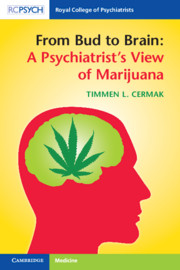Book contents
- From Bud to Brain: A Psychiatrist’s View of Marijuana
- From Bud to Brain: A Psychiatrist’s View of Marijuana
- Copyright page
- Dedication
- Contents
- Foreword
- Acknowledgments
- Introduction
- Section 1 The Science of Marijuana and the Brain
- Section 2 The Science and Art of Healing
- Chapter 10 Cannabinoid-Based Medication
- Chapter 11 Understanding and Encouragement
- Chapter 12 Principles of Motivational Interviewing
- Chapter 13 Treatment of Regular Heavy Marijuana Users
- Section 3 The History and Art of Marijuana Policy
- Section 4 Epilogue
- Index
Chapter 10 - Cannabinoid-Based Medication
from Section 2 - The Science and Art of Healing
Published online by Cambridge University Press: 31 March 2020
- From Bud to Brain: A Psychiatrist’s View of Marijuana
- From Bud to Brain: A Psychiatrist’s View of Marijuana
- Copyright page
- Dedication
- Contents
- Foreword
- Acknowledgments
- Introduction
- Section 1 The Science of Marijuana and the Brain
- Section 2 The Science and Art of Healing
- Chapter 10 Cannabinoid-Based Medication
- Chapter 11 Understanding and Encouragement
- Chapter 12 Principles of Motivational Interviewing
- Chapter 13 Treatment of Regular Heavy Marijuana Users
- Section 3 The History and Art of Marijuana Policy
- Section 4 Epilogue
- Index
Summary
After millennia of use as a folk remedy, the National Academies of Sciences, Engineering and Medicine declared there is conclusive or substantial evidence that cannabinoids are effective for the treatment of chronic pain in adults, nausea and vomiting due to chemotherapy and for improving the spasticity of multiple sclerosis. The Academies’ statement contradicts the FDA’s placing marijuana on Schedule I as a dangerous drug with no medical use. Considerable basic research also establishes its potential medical use for bone fractures, osteoporosis, head trauma, stroke, MI, cancer, stress related disease such as PTSD, inflammation, and neurodegenerative disease. Understanding the potential value of cannabinoid-based medications requires understand the function of our natural endocannabinoid system and the unique properties of CBD separate from THC. CBD produces many of marijuana’s medical benefits by altering how cannabinoid receptors respond to endocannabinoids and THC. CBD’s modulation of THC is particularly evident in its reduction of psychotic reactions to THC and possible value in treatment resistant schizophrenia. CBD has a high safety profile, may be useful for anxiety, insomnia, and has FDA approval for severe childhood epilepsy. Unfortunately, intensive marketing has made CBD a fad without rigorous scientific proofs of its often exaggerated benefits.
- Type
- Chapter
- Information
- From Bud to Brain: A Psychiatrist's View of Marijuana , pp. 137 - 163Publisher: Cambridge University PressPrint publication year: 2020

